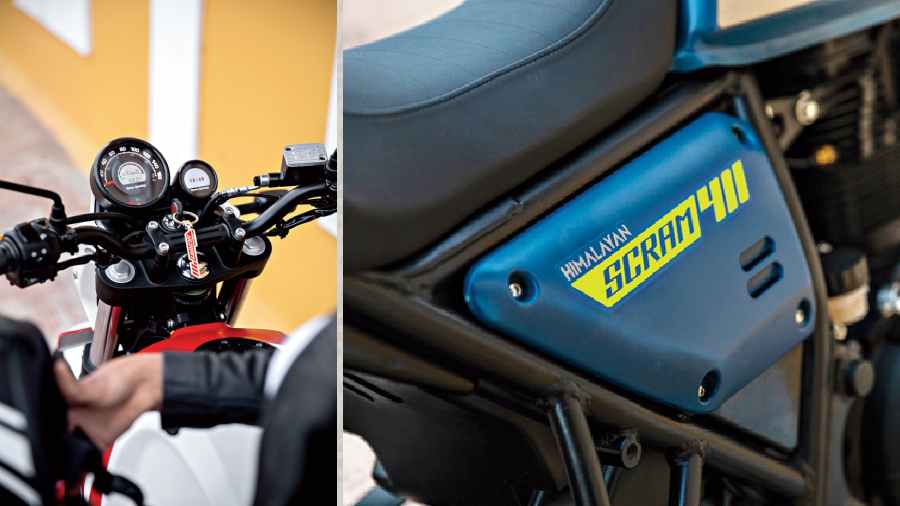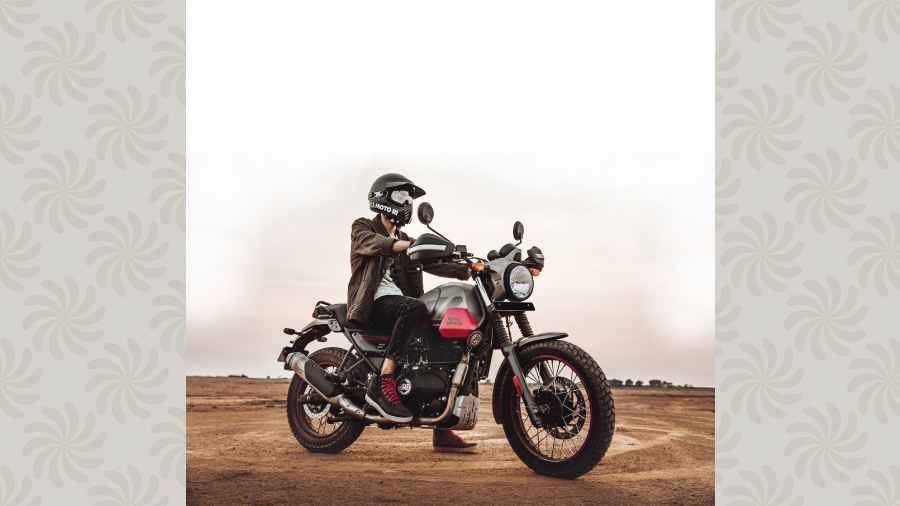It has been six years since Royal Enfield launched the Himalayan, the brand’s first ever foray into the rapidly expanding adventure motorcycle genre. From the Garden of Six Senses in Saket, Delhi, back in early 2016 to every Royal Enfield showroom across the country today, the Himalayan has scripted a success story for itself. What helped write a large part of this story were its sturdy frame, rough and ready construction and a brand new 411cc air-cooled, single-cylinder engine with an oil-cooler. The other, much newer, success story is that of the Meteor 350 that we reviewed just a few months ago right here on these very pages. So, I suppose the next logical step would be to see if these two success stories could be merged to some degree to create a third success story. The result is the Himalayan Scram 411, and the big question we’re putting out here is whether the Scram has what it takes to set the charts afire.
From the look of things
The eyes won’t have a tough time adjusting to the Scram’s visuals. What the folks at RE have done is drop that beaky nose, attach the headlamp to the forks like in most conventional motorcycles, swap the instrumentation from the Meteor and give the thing a smaller front wheel (from 21 inches to 19). Obviously, new and snazzy paint jobs finish the livery. The overall effect is pleasing. It doesn’t look like a modded Himalayan but a genuinely new motorcycle. For some strange reason, the new colour schemes also give the Scram an aura of sporty sophistication that you won’t find in the Himalayan.
Once you’re in the saddle, if you have the OG to compare with, you’ll notice that the riding posture is slightly altered. I actually liked it quite a bit and found the relation between the holy trinity — saddle, handlebars and footpegs — to be better suited to my riding style. Again, there’s a huge visual difference from the rider’s point of view. This is primarily due to the fact that from the saddle you’re looking at an entirely different instrument cluster — the digi-analogue round IP of the Meteor, plus the little sidepod developed in collaboration with Google to give out handy turn by turn directions once you’ve connected your cellphone to your bike via the Royal Enfield app. The other two reasons why it feels visually different is because of the absence of the flyscreen and the fact that unlike the frame-mounted headlamp of the Himalayan, here the light swivels with the forks.
For scramming around
The motorcycle gets the same 411cc single-cylinder air-cooled unit with oil-cooler that powers the Himalayan. Peak output is 24.3 bhp and 32 Nm, which is transmitted to the 17-inch rear wheel via a slick shifting five-speed box and a chain drive. There’s plenty of grunt for the rough and tumble world of the urban jungle, with much of it being spread low down in the rev range. That means you don’t find yourself constantly working through the gearbox to find the drive that will let you dart through gaps in the traffic. At the same time, this makes a highway jaunt fairly relaxed since it gives the bike decent cruising abilities.
In the city, the smaller front wheel results in easier flickability when you’re carving your way ahead through the tangle of drivers, rash autos and murderous buses. Its longish 1,455mm wheelbase keeps things stable while the suspension setup offers a good balance between ride quality and handling. Shorter riders will also find the slightly lower 795mm saddle height more convenient than on the Himalayan.
So what’s the catch?
After all, there is no such thing as a perfect motorcycle, is there? I would have had a few things to say about fit and finish and build quality, except that at Rs 2.03 lakh, ex-showroom everywhere, it is quite the bargain. Verdict? I’d be pretty surprised if Royal Enfield doesn’t get their third success story in the months to come.
Pictures courtesy Royal Enfield
The Scram 411 in numbers

Sourced by the correspondent
Engine Type: Air and oil-cooled, single cylinder with SOHC and EFI
Capacity: 411cc
Transmission: 5-speed, constant mesh
Maximum Power: 24.3bhp @ 6500rpm
Maximum Torque: 32Nm @ 4000-4500rpm
Fuel Tank Capacity: 15litres
Ground Clearance: 200mm
Length x Width: 2,160mm x 840mm
Wheelbase: 1,455mm
Saddle Height: 795mm
Kerb Weight: 185kg
Front Brake: 300mm disc with twin piston floating caliper, ABS
Rear Brake: 240mm disc with single piston floating caliper, ABS
Price: Rs 2.03 lakh ex-showroom Calcutta










